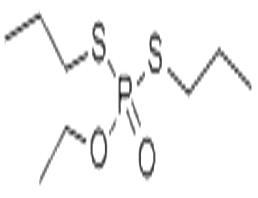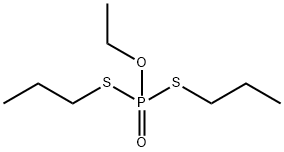| Chemical Properties |
Clear Colorless Oil |
| Uses |
Ethoprophos is an organophosphate non-systemic nematicide and soil insecticide. Ethoprophos is an acetylcholinesterase (AChE) inhibitor. |
| Uses |
Insecticide; nematocide. |
| General Description |
Ethorop is one of a family of organophosphorus pesticides. Mocap is combustible though Mocap may require some effort to ignite. Mocap is very toxic by skin absorption and inhalation. Mocap may or may not be water soluble. |
| Air & Water Reactions |
Hydrolyzed in alkali. |
| Reactivity Profile |
Organothiophosphates, such as Mocap, are susceptible to formation of highly toxic and flammable phosphine gas in the presence of strong reducing agents such as hydrides. Partial oxidation by oxidizing agents may result in the release of toxic phosphorus oxides. |
| Health Hazard |
Mocap is extremely toxic; the probable oral lethal dose for humans is 5-50 mg/kg, or between 7 drops and 1 teaspoonful for a 150 lb. person. It is a cholinesterase inhibitor which affects the nervous system. |
| Fire Hazard |
(Non-Specific -- Organophosphorus Pesticide, Liquid, n.o.s.) Container may explode in heat of fire. Fire and runoff from fire control water may produce irritating or poisonous gases. Stable in water. Hydrolyzed in alkali. |
| Agricultural Uses |
Nematicide, Insecticide: Ethoprop is used as a pre-plant soil application to control wireworms and nematodes in potatoes, sugar cane, sweet potatoes, and tobacco, with lesser usage on corn (field and sweet), beans (lima and snap), cucumbers, and cabbage. In addition, it is used to treat pineapples, bananas, and plantains, as well as fieldgrown ornamentals and non-bearing citrus trees, and commercial turf. Roughly 60% of ethoprop is applied to potatoes. |

 China
China








